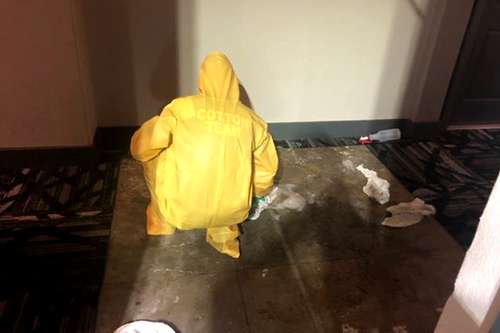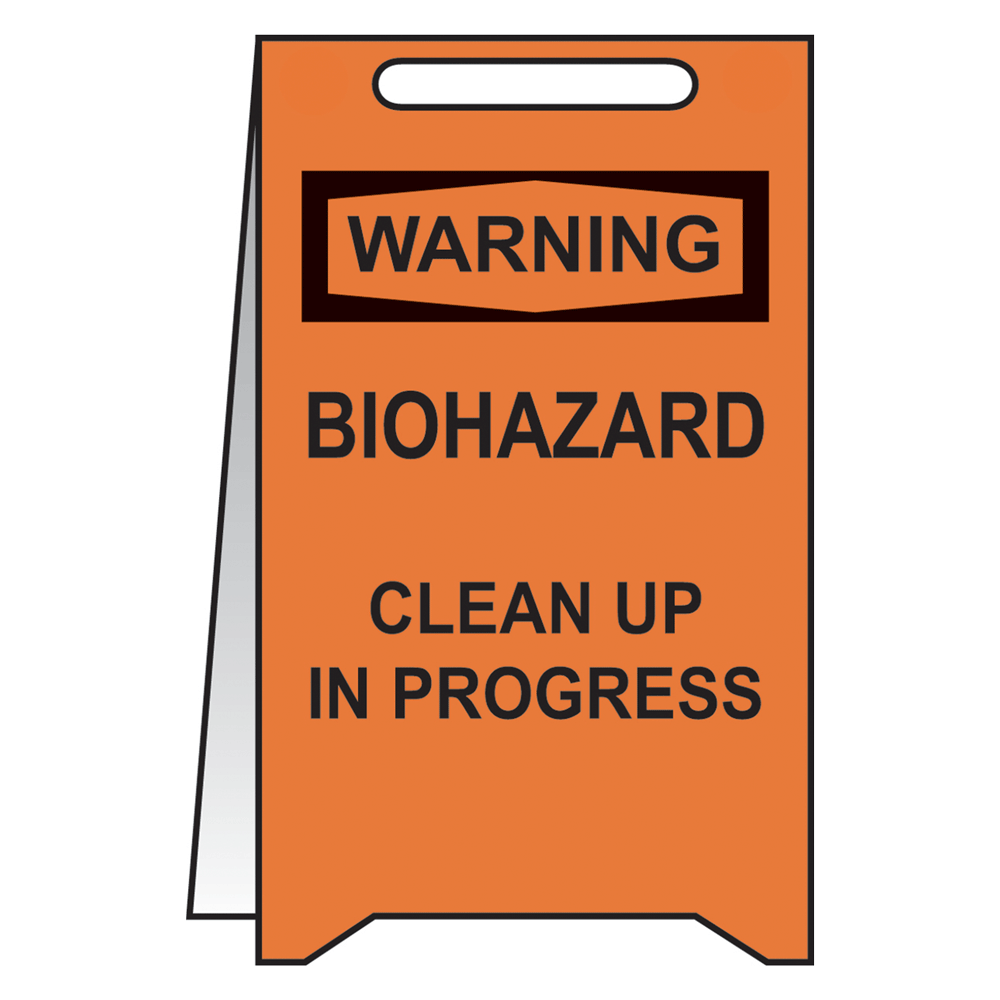Flood Damage Restoration: Quick and Effective Healing for Your Home
Flood Damage Restoration: Quick and Effective Healing for Your Home
Blog Article
Professional Biohazard Cleaning and Decontamination for Blood, Bodily Fluids, and Hazardous Products
The possible health dangers linked with exposure to biohazards emphasize the crucial demand for meticulous handling and complete cleanup. As we navigate the complex landscape of biohazard cleanup, comprehending the subtleties of regulations, compliance, and the customized tools at play becomes necessary in ensuring a comprehensive and risk-free purification procedure.
Health Dangers of Biohazard Direct Exposure
Direct exposure to biohazards postures significant health and wellness dangers that can cause extreme consequences for neighborhoods and people alike. Biohazards incorporate a vast array of biological substances, including blood, bodily fluids, mold, germs, viruses, and various other possibly contagious products. When people enter call with these biohazards, whether via crashes, inappropriate handling, or ecological direct exposure, they encounter the danger of having severe ailments or conditions.
Among the key wellness threats connected with biohazard direct exposure is the transmission of transmittable conditions. Bloodborne virus such as HIV, liver disease B and C, and numerous microorganisms can be existing in biohazardous products, positioning a direct threat to human health and wellness. Inhaling airborne biohazards like mold spores or coming right into contact with contaminated surface areas can additionally cause breathing problems, allergies, and various other negative health and wellness effects.
Furthermore, biohazard direct exposure can have lasting health and wellness implications, with some conditions showing up years after the first contact (Blood Cleanup). Consequently, it is critical to focus on proper biohazard cleaning and purification to mitigate these health risks and ensure the safety and security of individuals and communities

Specialized Training for Biohazard Cleaning
When it comes to managing biohazard cleaning efficiently and securely, specialized training plays a basic role in making sure correct decontamination treatments are adhered to. Biohazard cleanup needs certain knowledge and skills to successfully minimize risks related to bloodborne microorganisms, physical fluids, and dangerous materials. Specialists educated in biohazard cleanup undergo extensive direction on just how to securely handle, eliminate, and take care of biohazardous products to stop contamination and exposure.
Specialized training for biohazard clean-up covers a variety of necessary subjects, consisting of correct individual safety tools (PPE) use, bloodborne pathogen awareness, decontamination techniques, and dangerous waste disposal procedures. Individuals learnt biohazard clean-up are geared up with the required know-how to analyze contamination degrees, recognize possible threats, and apply ideal clean-up procedures in compliance with regulatory standards.
Continual training and education and learning are extremely important in the area of biohazard clean-up to stay updated on the most recent purification modern technologies, security protocols, and regulations. By spending in specialized training, biohazard cleaning experts can efficiently react to emergency situation clean-up situations and safeguard both public wellness and the atmosphere.
Significance of Proper Purification Methods
Utilizing correct decontamination techniques is critical in biohazard clean-up to efficiently remove harmful materials and decrease health dangers. Effective purification not only makes certain the removal of noticeable traces of blood, bodily liquids, and other biohazards yet also targets unseen microorganisms that might position significant health and wellness hazards if not effectively removed. By adhering to strict purification protocols, educated professionals can substantially reduce the danger of direct exposure to dangerous bacteria, infections, and bacteria that might lead to diseases or infections.
Appropriate purification techniques include the usage of customized equipment and disinfectants that are especially designed Discover More to reduce the effects of biohazards properly. Comprehensive cleansing and sanitation of infected areas are important to protect against the spread of pathogens and guarantee a secure environment for passengers. In addition, the correct disposal of biohazardous waste following decontamination procedures is crucial in protecting against contamination of other surfaces or individuals.

Tools and Devices for Safe Clean-up
When dealing with blood, bodily liquids, or dangerous products, biohazard cleaning specialists rely on specialized equipment to minimize exposure threats and thoroughly sanitize the affected area. In addition, biohazard cleaning sets having disinfectants, absorbing products, and biohazard bags are utilized to securely get rid of and have of contaminated products.
Advanced cleansing tools like hospital-grade disinfectants, HEPA-filtered vacuum cleaners, and misting devices are utilized to disinfect surfaces and remove biohazards successfully. Specialized tools such as sharps containers and biohazard waste disposal bins are used to securely manage sharp objects and biohazardous waste materials. By using the appropriate equipment and tools, biohazard cleaning experts can make certain a thorough cleanup process that focuses on security and decreases health risks for both workers and residents of the afflicted area.
Laws and Conformity in Biohazard Cleansing
Correct adherence to laws and conformity criteria is paramount in biohazard cleaning to ensure the safety of both personnel and the environment. Government agencies such as OSHA (Occupational Safety and Health Management) and the EPA (Environmental Protection Firm) have actually developed certain standards for biohazard clean-up procedures to reduce health and wellness risks and ecological contamination. These laws cover an array of elements including the handling, transportation, and disposal of biohazardous materials, along with the essential training and safety devices required for personnel associated with the clean-up process.
Biohazard cleaning firms have to remain updated with these regulations to guarantee that their procedures satisfy the required safety criteria. Failure to abide by these laws can cause serious consequences, consisting of fines, lawsuit, and endangering the wellness of people and the environment. By adhering to rigid policies and conformity steps, biohazard cleansing business can effectively minimize dangers and ensure a detailed and risk-free clean-up procedure for all celebrations entailed.
Final Thought
In conclusion, biohazard cleansing and purification need customized training, appropriate strategies, and adherence to policies. Direct exposure to blood, bodily fluids, and hazardous products poses considerable health and wellness threats, making it critical to use the right equipment and tools for risk-free cleanup. By adhering to strict methods and guidelines, experts can properly minimize the risks connected with biohazard direct exposure and guarantee the safety and security of both themselves and others.
As we browse the elaborate landscape of biohazard clean-up, recognizing the subtleties of regulations, compliance, and the specific tools at play becomes necessary in find out ensuring a thorough and safe decontamination process. (Blood Cleanup)
When it comes to managing biohazard cleaning successfully and securely, specialized training plays a basic role in ensuring proper decontamination procedures are followed.Utilizing proper decontamination techniques is important in biohazard clean-up to successfully lessen and get rid of dangerous materials health risks. Additionally, biohazard cleansing packages having anti-bacterials, absorptive materials, and biohazard bags this post are used to safely contain and get rid of of infected products.
Government agencies such as OSHA (Occupational Safety And Security and Wellness Management) and the EPA (Environmental Security Agency) have actually developed particular guidelines for biohazard cleaning treatments to reduce health threats and ecological contamination.
Report this page